BiLSTM+CRF及pytorch实现
前言
对于命名实体识别任务,基于神经网络的方法非常普遍。例如,Neural Architectures for Named Entity Recognition提出了一个使用word and character embeddings的BiLSTM-CRF命名实体识别模型。我将以本文中的模型为例来解释CRF层是如何工作的。如果你不知道BiLSTM和CRF的细节,请记住它们是命名实体识别模型中的两个不同的层。
在开始我们下面将进行的讨论之前,我们先假设,我们有一个数据集,其中有两个实体类型:Person和Organization。但是,事实上,在我们的数据集中,我们有5个实体标签:
- B-Person
- I- Person
- B-Organization
- I-Organization
- O
此外,x是一个包含5个单词的句子,w0,w1,w2,w3,w4。更重要的是,在句子x中,[w0,w1]是一个Person实体,[w3]是一个Organization实体,其他都是“O”。
BiLSTM+CRF模型
概述
我将对这个模型做一个简单的介绍。
如下图所示:
- 首先,将句子x中的每个单词表示为一个向量,其中包括单词的嵌入和字符的嵌入。字符嵌入是随机初始化的。词嵌入通常是从一个预先训练的词嵌入文件导入的。所有的嵌入将在训练过程中进行微调。
- 第二,BiLSTM-CRF模型的输入是这些嵌入,输出是句子x中的单词的预测标签。
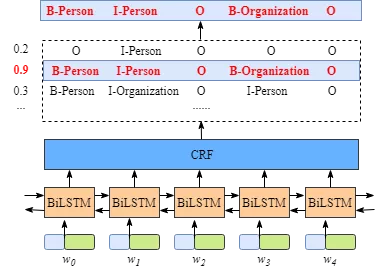
虽然不需要知道BiLSTM层的细节,但是为了更容易的理解CRF层,我们需要知道BiLSTM层输出的意义是什么。

上图说明BiLSTM层的输出是每个标签的分数。例如,对于w0, BiLSTM节点的输出为1.5 (B-Person)、0.9 (I-Person)、0.1 (B-Organization)、0.08 (I-Organization)和0.05 (O),这些分数将作为CRF层的输入。
然后,将BiLSTM层预测的所有分数输入CRF层。在CRF层中,选择预测得分最高的标签序列作为最佳答案。
为什么需要添加CRF层?
你可能已经发现,即使没有CRF层,也就是说,我们可以训练一个BiLSTM命名实体识别模型,如下图所示。
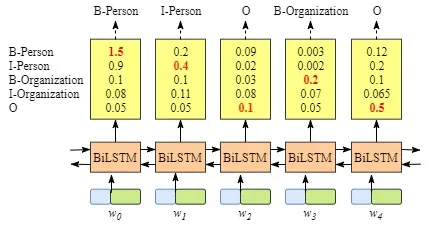
因为每个单词的BiLSTM的输出是标签分数。我们可以选择每个单词得分最高的标签。例如,对于w0,“B-Person”得分最高(1.5),因此我们可以选择“B-Person”作为其最佳预测标签。同样,我们可以为w1选择“I-Person”,为w2选择“O”,为w3选择“B-Organization”,为w4选择“O”。
虽然在这个例子中我们可以得到正确的句子x的标签,但是并不总是这样。再试一下下面图片中的例子。
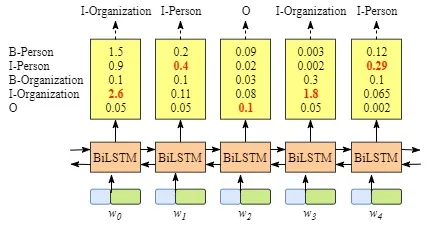
显然,这次的输出是无效的,“I-Organization I-Person”和“B-Organization I-Person”。
CRF层可以向最终的预测标签添加一些约束,以确保它们是有效的。这些约束可以由CRF层在训练过程中从训练数据集自动学习。
约束条件可以是:
- 句子中第一个单词的标签应该以“B-”或“O”开头,而不是“I-”
- “B-label1 I-label2 I-label3 I-…”,在这个模式中,label1、label2、label3…应该是相同的命名实体标签。例如,“B-Person I-Person”是有效的,但是“B-Person I-Organization”是无效的。
- “O I-label”无效。一个命名实体的第一个标签应该以“B-”而不是“I-”开头,换句话说,有效的模式应该是“O B-label”
- …
有了这些有用的约束,无效预测标签序列的数量将显著减少。
CRF层
在这一节中,我将分析CRF损失函数,来解释CRF层如何或为什么能够从训练数据集中学习上述约束。
在CRF层的损失函数中,我们有两种类型的分数。这两个分数是CRF层的关键概念。
Emission score
第一个是emission分数。这些emission分数来自BiLSTM层。例如,如图2.1所示,标记为B-Person的w0的分数为1.5。
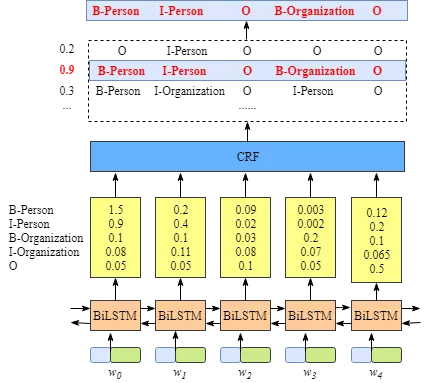
为了方便起见,我们将给每个标签一个索引号,如下表所示。

我们用\(x_{iy_j}\)来表示emission分数。\(i\)是word的索引,\(y_j\)是label的索引。如图2.1所示,\(x_{i=1,y_j=2} = x_{w_1,B-Organization} = 0.1\),即 \(w_1\)作为B-Organization的得分为0.1。
Transition score
我们使用\(t_{y_iy_j}\)来表示transition分数。例如,\(t_{B-Person, I-Person} = 0.9\)表示标签的transition,\(B-Person \rightarrow I-Person\)得分为0.9。因此,我们有一个transition得分矩阵,它存储了所有标签之间的所有得分。
为了使transition评分矩阵更健壮,我们将添加另外两个标签,START和END。START是指一个句子的开头,而不是第一个单词。END表示句子的结尾。
下面是一个transition得分矩阵的例子,包括额外添加的START和END标签。

如上表所示,我们可以发现transition矩阵已经学习了一些有用的约束。
- 句子中第一个单词的标签应该以“B-”或“O”开头,而不是“I-”开头(从“START”到“I- person或I- organization”的transition分数非常低)
- “B-label1 I-label2 I-label3 I-…”,在这个模式中,label1、label2、label3…应该是相同的命名实体标签。例如,“B-Person I-Person”是有效的,但是“B-Person I-Organization”是无效的。(例如,从“B--- Organization”到“I-Person”的分数只有0.0003,比其他分数低很多)
- “O I-label”无效。一个被命名实体的第一个标签应该以“B-”而不是“I-”开头,换句话说,有效的模式应该是“O B-label”(同样,的分数非常小)
- …
你可能想问一个关于矩阵的问题。在哪里或如何得到transition矩阵?
实际上,该矩阵是BiLSTM-CRF模型的一个参数。在训练模型之前,可以随机初始化矩阵中的所有transition分数。所有的随机分数将在你的训练过程中自动更新。换句话说,CRF层可以自己学习这些约束。我们不需要手动构建矩阵。随着训练迭代次数的增加,分数会逐渐趋于合理。
CRF损失函数
CRF损失函数由真实路径得分和所有可能路径的总得分组成。在所有可能的路径中,真实路径的得分应该是最高的。
例如,如果我们的数据集中有如下表所示的这些标签:
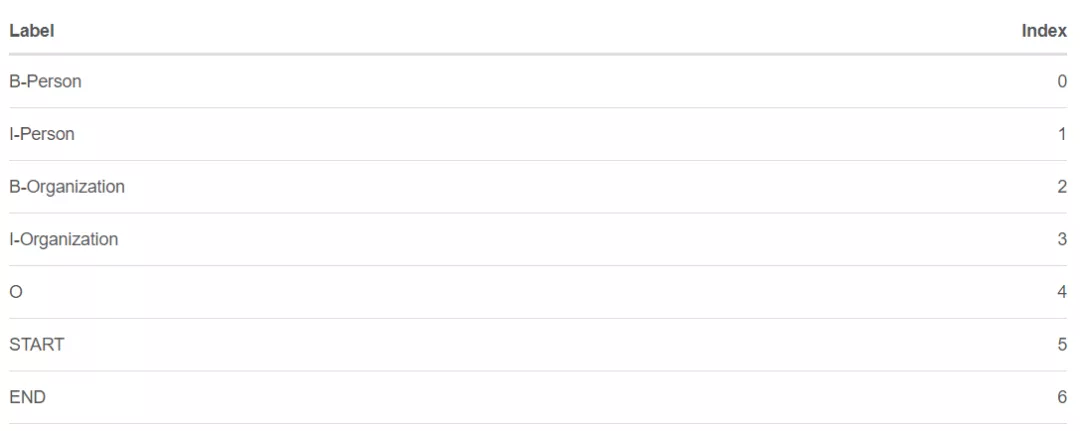
我们还是有一个5个单词的句子。可能的路径是:
-
- START B-Person B-Person B-Person B-Person B-Person END
-
- START B-Person I-Person B-Person B-Person B-Person END
- …
- 10) START B-Person I-Person O B-Organization O END
- …
- N) O O O O O O O
假设每条可能的路径都有一个分数\(P_{i}\),并且总共有\(N\)条可能的路径,所有路径的总分数是\(P_{total} = P_1 + P_2 + … + P_N = e^{S_1} + e^{S_2} + … + e^{S_N}\)。(在第2.4节中,我们将解释如何计算\(S_i\),你也可以把它当作这条路径的分数。)
如果我们说第10条路径是真正的路径,换句话说,第10条路径是我们的训练数据集提供的黄金标准标签。在所有可能的路径中,得分\(P_{10}\)应该是百分比最大的。
在训练过程中,我们的BiLSTM-CRF模型的参数值将会一次又一次的更新,以保持增加真实路径的分数百分比。
\(Loss Function = \frac{P_{RealPath}}{P_1 + P_2 + … + P_N}\)
现在的问题是:
- 1)如何定义一个路径的分数?
- 2)如何计算所有可能路径的总分?
- 3)当我们计算总分时,我们需要列出所有可能的路径吗?(这个问题的答案是否定的.)
在下面的小节中,我们将看到如何解决这些问题。
实际路径得分
显然,在所有可能的路径中,一定有一条是真实路径。上节例子中句子的实际路径是“START B-Person I-Person O B-Organization O END”。其他的是不正确的,如“START B-Person B-Organization O I-Person I-Person B-Person”。\(e^{S_i}\)是第i条路径的得分。
在训练过程中,CRF损失函数只需要两个分数:真实路径的分数和所有可能路径的总分数。所有可能路径的分数中,真实路径分数所占的比例会逐渐增加。
计算实际路径分数\(e^{S_i}\)非常简单。这里我们主要关注的是\({S_i}\)的计算。
选取真实路径,“START B-Person I-Person O B-Organization O END”,我们以前用过,例如:
-
我们有一个5个单词的句子,w1,w2,w3,w4, w4,w5
-
我们增加了两个额外的单词来表示一个句子的开始和结束,w0,w6
-
\({S_i}\)由两部分组成:\(S_i = EmissionScore + TransitionScore\)
Emission得分:
\(EmissionScore=x_{0,START}+x_{1,B-Person}+x_{2,I-Person}+x_{3,O}+x_{4,B-Organization}+x_{5,O}+x_{6,END}\)
-
\(x_{index,label}\)是第index个单词被label标记的分数
-
这些得分$x_{1,B-Person} $ $ x_{2,I-Person} $ $ x_{3,O} $ $ x_{4,Organization} $ $ x_{5,O}$来自之前的BiLSTM输出。
-
对于\(x_{0,START}\)和\(x_{6,END}\),我们可以把它们设为0。
Transition得分:

- \(t_{label1 \rightarrow label2}\)是从\(label1\)到\(label2\)的transition分数
- 这些分数来自CRF层。换句话说,这些transition分数实际上是CRF层的参数。
综上所述,现在我们可以计算出\(S_i\)以及路径得分\(e^{S_i}\)。
所有可能的路径的总得分
衡量总分最简单的方法是:列举所有可能的路径并将它们的分数相加。是的,你可以用这种方法计算总分。然而,这是非常低效的。训练的时间将是难以忍受的。下面我们将会通过一个toy例子,如何逐步计算一个句子的所有可能的路径的总分。下面我们开始在探索吧。
步骤1: 回想一下CRF损失函数
之前,我们将CRF损失函数定义为:
\(Loss Function = \frac{P_{RealPath}}{P_1 + P_2 + … + P_N}\)
现在我们把loss函数改变为对数loss函数:
\(LogLossFunction = \log \frac{P_{RealPath}}{P_1 + P_2 + … + P_N}\)
当我们训练一个模型时,通常我们的目标是最小化我们的损失函数,因此我们加上一个负号:
\(Log Loss Function = - \log \frac{P_{RealPath}}{P_1 + P_2 + … + P_N}\)
\(= - \log \frac{e^{S_{RealPath}}}{e^{S_1} + e^{S_2} + … + e^{S_N}}\)
\(= - (\log(e^{S_{RealPath}}) - \log(e^{S_1} + e^{S_2} + … + e^{S_N}))\)
\(= - (S_{RealPath} - \log(e^{S_1} + e^{S_2} + … + e^{S_N}))\)
\(= - ( \sum_{i=1}^{N} x_{iy_i} + \sum_{i=1}^{N-1} t_{y_iy_{i+1}} - \log(e^{S_1} + e^{S_2} + … + e^{S_N}))\)
在上一节中,我们已经知道如何计算实际路径得分,现在我们需要找到一个有效的解决方案来计算\(\log(e^{S_1} + e^{S_2} + … + e^{S_N})\)
步骤2: 回忆一下Emission和Transition得分
为了简化,我们假设我们从这个toy句子中训练我们的模型,它的长度只有3:
\(\mathbf{x} = [w_0, w_1, w_2]\)
此外,在我们的数据集中,我们有两个标签:
\(LabelSet = \{l_1,l_2\}\)
我们还有Bi-LSTM层输出的Emission分数:

\(x_{ij}\)表示\(w_i\)被标记为\(l_j\)的得分。
此外,还有来自CRF层的Transition分数:

\(t_{ij}\)是从标签i到标签j的transition得分。
步骤3: 开始战斗(准备好纸笔):
Remeber: Our goal is: \(log(e^{S1}+e^{S2}+…+e^{SN})\)
这个过程就是分数的累加。其思想与动态规划相似。简而言之,计算w0的所有可能路径的总分。然后,我们用总分来计算w0→w1。最后,我们使用最新的总分来计算w0→w1→w2。我们需要的是最后的总分。 在接下来的步骤中,你将看到两个变量:obs和previous。previous存储前面步骤的最终结果。obs表示当前单词的信息。
- previous:是一个向量,维数为标签tag的个数,每一维存储的是上一个位置所有的以某个tag为结尾的路径总分数的log之后的值
- obs:是一个向量,维数为标签tag的个数,每一维存储的是当前位置所对应的为某个tag的emission score。
w0:
\(obs = [x_{01}, x_{02}]\)
\(previous = None\)
如果我们的句子只有一个单词\(w_0\),我们就没有前面步骤的结果,因此\(previous\)是\(None\)。另外,我们只能观察到第一个词\(obs = [x_{01}, x_{02}]\)。\(x_{01}\)和\(x_{02}\)是上述的Emission分数。
你可能会想,\(w_0\)的所有可能路径的总分是多少?答案很简单:
\(TotalScore(w_0)=\log (e^{x_{01}} + e^{x_{02}})\)
w0 \(\rightarrow\) w1:
\(obs = [x_{11}, x_{12}]\)
\(previous = [x_{01}, x_{02}]\)
1)把previous展开成:
\(previous =\left( \begin{matrix} x_{01}&x_{01}\\x_{02}&x_{02} \end{matrix} \right)\)
2)把obs展开成:
\(obs =\left(
\begin{matrix}
x_{11}&x_{12}\\
x_{11}&x_{12}
\end{matrix}
\right)\)
你可能想知道,为什么我们需要把previous和obs扩展成矩阵。因为矩阵可以提高计算的效率。在下面的过程中,你将很快看到这一点。
3)对 previous, obs以及transition得分求和:
\(scores =\left(
\begin{matrix}
x_{01}&x_{01}\\x_{02}&x_{02}
\end{matrix}
\right)
+
\left(
\begin{matrix}
x_{11}&x_{12}\\x_{11}&x_{12}
\end{matrix}
\right)
+
\left(
\begin{matrix}
t_{11}&t_{12}\\t_{21}&t_{22}
\end{matrix}
\right)\)
然后:
\(scores =\left(
\begin{matrix}
x_{01}+x_{11}+t_{11}&x_{01}+x_{12}+t_{12}\\
x_{02}+x_{11}+t_{21}&x_{02}+x_{12}+t_{22}
\end{matrix}
\right)\)
为下一个迭代修改previous的值:
\(previous=[\log (e^{x_{01}+x_{11}+t_{11}} + e^{x_{02}+x_{11}+t_{21}}), \log (e^{x_{01}+x_{12}+t_{12}} + e^{x_{02}+x_{12}+t_{22}})]\)
实际上,第二次迭代已经完成。如果有人想知道如何计算所有可能路径的总分(\(label_1\) \(\rightarrow\) \(label_1\), \(label_1\) \(\rightarrow\) \(label_2\), \(label_2\) \(\rightarrow\) \(label_1\), \(label_2\) \(\rightarrow\) \(label_2\)),从\(w_0\)到\(w_1\),可以做如下计算。
我们使用新的previous中的元素:
\(TotalScore(w_0 \rightarrow w_1)\)
\(
=\log (e^{previous[0]} + e^{previous[1]})\)
\(
=\log (e^{\log(e^{x_{01}+x_{11}+t_{11}} + e^{x_{02}+x_{11}+t_{21}})}+e^{\log(e^{x_{01}+x_{12}+t_{12}} + e^{x_{02}+x_{12}+t_{22}})})\)
\(
=\log(e^{x_{01}+x_{11}+t_{11}}+e^{x_{02}+x_{11}+t_{21}}+e^{x_{01}+x_{12}+t_{12}}+e^{x_{02}+x_{12}+t_{22}})\)
你发现了吗?这正是我们的目标:\(\log(e^{S_1} + e^{S_2} + … + e^{S_N})\)
在这个等式中,我们可以看到:
- \(S_1 = x_{01}+x_{11}+t_{11}\) (\(label_1\) → \(label_1\))
- \(S_2 = x_{02}+x_{11}+t_{21}\) (\(label_2\) → \(label_1\))
- \(S_3 = x_{01}+x_{12}+t_{12}\) (\(label_1\) → \(label_2\))
- \(S_4 = x_{02}+x_{12}+t_{22}\) (\(label_2\) → \(label_2\))
w0 → w1 → w2:
如果你读到这里了,你已经快要读完了,实际上,在这个迭代里,我们做的事情是和上个迭代一样的。
\(obs = [x_{21}, x_{22}]\)
\(previous=[\log (e^{x_{01}+x_{11}+t_{11}} + e^{x_{02}+x_{11}+t_{21}}), \log (e^{x_{01}+x_{12}+t_{12}} + e^{x_{02}+x_{12}+t_{22}})]\)
1)把previous扩展成:
\(previous
=\left(
\begin{matrix}
\log (e^{x_{01}+x_{11}+t_{11}} + e^{x_{02}+x_{11}+t_{21}})&\log (e^{x_{01}+x_{11}+t_{11}} + e^{x_{02}+x_{11}+t_{21}})\\
\log (e^{x_{01}+x_{12}+t_{12}} + e^{x_{02}+x_{12}+t_{22}})&\log (e^{x_{01}+x_{12}+t_{12}} + e^{x_{02}+x_{12}+t_{22}})
\end{matrix}
\right)\)
2)把obs扩展成:
\(obs =\left(
\begin{matrix}
x_{21}&x_{22}\\
x_{21}&x_{22}
\end{matrix}
\right)\)
3)把previous, obs和transition分数加起来:
\(scores =
\left(
\begin{matrix}
\log (e^{x_{01}+x_{11}+t_{11}} + e^{x_{02}+x_{11}+t_{21}})&\log (e^{x_{01}+x_{11}+t_{11}} + e^{x_{02}+x_{11}+t_{21}})\\
\log (e^{x_{01}+x_{12}+t_{12}} + e^{x_{02}+x_{12}+t_{22}})&\log (e^{x_{01}+x_{12}+t_{12}} + e^{x_{02}+x_{12}+t_{22}})
\end{matrix}
\right)
+
\left(
\begin{matrix}
x_{21}&x_{22}\\
x_{21}&x_{22}
\end{matrix}
\right)
+
\left(
\begin{matrix}
t_{11}&t_{12}\\
t_{21}&t_{22}
\end{matrix}
\right)\)
然后:
\(scores =
\left(
\begin{matrix}
\log (e^{x_{01}+x_{11}+t_{11}} + e^{x_{02}+x_{11}+t_{21}}) + x_{21} + t_{11}
&\log (e^{x_{01}+x_{11}+t_{11}} + e^{x_{02}+x_{11}+t_{21}}) + x_{22} + t_{12}\\
\log (e^{x_{01}+x_{12}+t_{12}} + e^{x_{02}+x_{12}+t_{22}}) + x_{21} + t_{21}
&\log (e^{x_{01}+x_{12}+t_{12}} + e^{x_{02}+x_{12}+t_{22}}) + x_{22} + t_{22}
\end{matrix}
\right)\)
为下一轮迭代改变previous的值:
\(previous=[\) \(\log(
e^{\log (e^{x_{01}+x_{11}+t_{11}} + e^{x_{02}+x_{11}+t_{21}}) + x_{21} + t_{11}}
+
e^{\log (e^{x_{01}+x_{12}+t_{12}} + e^{x_{02}+x_{12}+t_{22}}) + x_{21} + t_{21}}
)\),\(\log(
e^{\log (e^{x_{01}+x_{11}+t_{11}} + e^{x_{02}+x_{11}+t_{21}}) + x_{22} + t_{12}}
+
e^{\log (e^{x_{01}+x_{12}+t_{12}} + e^{x_{02}+x_{12}+t_{22}}) + x_{22} + t_{22}})\)]
\(=[\log((e^{x_{01}+x_{11}+t_{11}} + e^{x_{02}+x_{11}+t_{21}})e^{x_{21} + t_{11}}+(e^{x_{01}+x_{12}+t_{12}} + e^{x_{02}+x_{12}+t_{22}})e^{x_{21} + t_{21}}),\log((e^{x_{01}+x_{11}+t_{11}} + e^{x_{02}+x_{11}+t_{21}})e^{x_{22} + t_{12}}+(e^{x_{01}+x_{12}+t_{12}} + e^{x_{02}+x_{12}+t_{22}})e^{x_{22} + t_{22}})]\)
就像上一个迭代描述的一样,我们使用新的previous中的元素来计算总分数:
\(TotalScore(w_0 \rightarrow w_1 \rightarrow w_2)\)
\(=\log (e^{previous[0]} + e^{previous[1]})\)
\(=\log (e^{\log((e^{x_{01}+x_{11}+t_{11}} + e^{x_{02}+x_{11}+t_{21}})e^{x_{21} + t_{11}}+(e^{x_{01}+x_{12}+t_{12}} + e^{x_{02}+x_{12}+t_{22}})e^{x_{21} + t_{21}})}+e^{\log((e^{x_{01}+x_{11}+t_{11}} + e^{x_{02}+x_{11}+t_{21}})e^{x_{22} + t_{12}}+(e^{x_{01}+x_{12}+t_{12}} + e^{x_{02}+x_{12}+t_{22}})e^{x_{22} + t_{22}})})\)
\(=\log (e^{x_{01}+x_{11}+t_{11}+x_{21}+t_{11}}+e^{x_{02}+x_{11}+t_{21}+x_{21}+t_{11}}+e^{x_{01}+x_{12}+t_{12}+x_{21}+t_{21}}+e^{x_{02}+x_{12}+t_{22}+x_{21}+t_{21}}+e^{x_{01}+x_{11}+t_{11}+x_{22}+t_{12}}+e^{x_{02}+x_{11}+t_{21}+x_{22}+t_{12}}+e^{x_{01}+x_{12}+t_{12}+x_{22}+t_{22}}+e^{x_{02}+x_{12}+t_{22}+x_{22}+t_{22}})\)
我们达到了目标,\(\log(e^{S_1} + e^{S_2} + … + e^{S_N})\).我们的toy句子有三个单词,label set有两个label,所以一共应该有8种可能的label path。
虽然这个过程相当复杂,但是实现这个算法要容易得多。使用计算机的优点之一是可以完成一些重复性的工作。
为新的句子推断标签(维特比解码)
在前面的章节中,我们学习了BiLSTM-CRF模型的结构和CRF损失函数的细节。你可以通过各种开源框架(Keras、TensorFlow、pytorch等)实现自己的BiLSTM-CRF模型。最重要的事情之一是模型的反向传播是在这些框架上自动计算的,因此你不需要自己实现反向传播来训练你的模型(即计算梯度和更新参数)。此外,一些框架已经实现了CRF层,因此将CRF层与你自己的模型结合起来非常容易,只需添加一行代码即可。
在本节中,我们将探索如何在模型准备好时在测试期间推断句子的标签。
步骤1:BiLSTM-CRF模型的Emission和transition得分
假设,我们有一个包含三个单词的句子:\(\mathbf{x} = [w_0, w_1, w_2]\)
此外,我们已经从BiLSTM模型得到了Emission分数,从下面的CRF层得到了transition分数:
| l1 | l2 | |
|---|---|---|
| w0 | x01 | x02 |
| w1 | x11 | x12 |
| w2 | x21 | x22 |
\(x_{ij}\)表示\(w_i\)被标记为\(l_j\)的得分。
| l1 | l2 | |
|---|---|---|
| l1 | t11 | t12 |
| l2 | t21 | t22 |
\(t_{ij}\)是从标签i转换成标签j的得分。
步骤2:开始推断
如果你熟悉Viterbi算法,那么这一部分对你来说很容易。但如果你不熟悉,请不要担心。与前一节类似,我将逐步解释该算法(先进行一个从左到右的前向过程,再从右到左进行回溯)。我们将从句子的左到右进行推断算法,如下所示:
- w0
- w0 → w1
- w0 → w1 → w2
你会看到两个变量:obs和previous。previous存储前面步骤的最终结果。obs表示当前单词的信息。
\(\mathbf{alpha_0}\)是历史最好得分,\(\mathbf{alpha_1}\)是历史对应的索引。这两个变量的细节将在它们出现时进行解释(方便我们进行回溯)。
w0:
\(obs = [x_{01}, x_{02}]\)
\(previous = None\)
现在,我们观察第一个单词\(w_{0}\),目前为止,\(w_{0}\)最好的标签是很明显的。
比如,如果\(obs = [x_{01}=0.2, x_{02}=0.8]\),很显然,\(w_{0}\)的最佳的标签是\(l_2\)。
因为只有一个单词,而且没有标签直接的转换,transition的得分没有用到。
w0 → w1:
\(obs = [x_{11}, x_{12}]\)
\(previous = [x_{01}, x_{02}]\)
1)把previous扩展成:
\(previous =
\left(
\begin{matrix}
previous[0]&previous[0]\\
previous[1]&previous[1]
\end{matrix}
\right)=
\left(
\begin{matrix}
x_{01}&x_{01}\\
x_{02}&x_{02}
\end{matrix}
\right)\)
2)把obs扩展成:
\(obs =
\left(
\begin{matrix}
obs[0]&obs[1]\\
obs[0]&obs[1]
\end{matrix}
\right)=
\left(
\begin{matrix}
x_{11}&x_{12}\\
x_{11}&x_{12}
\end{matrix}
\right)\)
3)把previous, obs和transition 分数都加起来:
\(scores =
\left(
\begin{matrix}
x_{01}&x_{01}\\
x_{02}&x_{02}
\end{matrix}
\right)
+
\left(
\begin{matrix}
x_{11}&x_{12}\\
x_{11}&x_{12}
\end{matrix}
\right)
+
\left(
\begin{matrix}
t_{11}&t_{12}\\
t_{21}&t_{22}
\end{matrix}
\right)\)
然后:
\(scores =
\left(
\begin{matrix}
x_{01}+x_{11}+t_{11}&x_{01}+x_{12}+t_{12}\\
x_{02}+x_{11}+t_{21}&x_{02}+x_{12}+t_{22}
\end{matrix}
\right)\)
你可能好奇,当我们计算所有路径的总分时,与上一节没有什么不同。请耐心和细心,你很快就会看到区别。
为下一次迭代更改previous的值:
\(previous=[\max (scores[00], scores[10]),\max (scores[01],scores[11])]\)
比如,如果我们的得分是:
\(scores =
\left(
\begin{matrix}
x_{01}+x_{11}+t_{11}&x_{01}+x_{12}+t_{12}\\
x_{02}+x_{11}+t_{21}&x_{02}+x_{12}+t_{22}
\end{matrix}
\right)\) \(=
\left(
\begin{matrix}
0.2&0.3\\
0.5&0.4
\end{matrix}
\right)\)
我们的下个迭代的previous是:
\(previous=[\max (scores[00], scores[10]),\max (scores[01],scores[11])] = [0.5, 0.4]\)
previous列表存储了当前单词的每个标签的最大得分。
[Example Start]
举个例子:
我们知道在我们的语料中,我们总共只有2个标签,\(label1(l_1)\)和\(label2(l_2)\)。这两个标签的索引分别是0和1(因为在程序中index从0开始而不是1)。
\(previous[0]\)是以第0个标签\(l_1\)为结尾的路径的最大得分,类似的previous[1]是以第1个标签\(l_2\)为结尾的路径的最大得分。在每个迭代中,变量previous存储了以每个标签为结尾的路径的最大得分。换句话说,在每个迭代中,我们只保留了每个标签的最佳路径的信息 \((previous=[max(scores[00],scores[10]),max(scores[01],scores[11])])\)
具有小得分的路径信息会被丢掉。
[Example End]
回到我们的主任务:
同时,我们还有两个变量用来存储历史信息(得分和索引),\(alpha_0\)和\(alpha_1\)。
在这个迭代中,我们把最佳得分放入\(alpha_0\),为了方便,每个标签的最大得分会加上下划线。
\(scores = \left( \begin{matrix} x_{01}+x_{11}+t_{11}&x_{01}+x_{12}+t_{12}\\ \underline{x_{02}+x_{11}+t_{21}}&\underline{x_{02}+x_{12}+t_{22}} \end{matrix} \right)= \left( \begin{matrix} 0.2&0.3\\ \underline{0.5}&\underline{0.4} \end{matrix} \right)\)
\(alpha_0=[(scores[10],scores[11])]=[(0.5,0.4)]\)
另外,对应的列的索引(当前词前一个词的状态的index)存在\(alpha_1\)里。
\(alpha_1=[(ColumnIndex(scores[10]),ColumnIndex(scores[11]))]=[(1,1)]\)
说明一下,\(l_1\)的索引是0,\(l_2\)的索引是1,所以\((1,1)=(l_2,l_2)\)表示,对于当前的单词\(w_i\)和标签\(l^{(i)}\):
当路径是\(\underline{l^{(i-1)}=l_2}\) → \(\underline{l^{(i)}=l_1}\)的时候,我们可以得到最大的得分是0.5,当路径是\(\underline{l^{(i-1)}=l_2}\) → \(\underline{l^{(i)}=l_2}\)的时候,我们可以得到最大的得分是0.4。\(l^{(i-1)}\)是前一个单词\(w_{i-1}\)的标签。
w0 → w1 → w2:
\(obs = [x_{21}, x_{22}]\)
\(previous = [0.5, 0.4]\)
1)把previous扩展成:
\(previous =
\left(
\begin{matrix}
previous[0]&previous[0]\\
previous[1]&previous[1]
\end{matrix}
\right)=
\left(
\begin{matrix}
0.5&0.5\\
0.4&0.4
\end{matrix}
\right)
\)
2)把obs扩展成:
\(obs =
\left(
\begin{matrix}
obs[0]&obs[1]\\
obs[0]&obs[1]
\end{matrix}
\right)=
\left(
\begin{matrix}
x_{21}&x_{22}\\
x_{21}&x_{22}
\end{matrix}
\right)\)
3)把previous, obs和transition 分数都加起来:
\(scores =
\left(
\begin{matrix}
0.5&0.5\\
0.4&0.4
\end{matrix}
\right)
+
\left(
\begin{matrix}
x_{21}&x_{22}\\
x_{21}&x_{22}
\end{matrix}
\right)
+
\left(
\begin{matrix}
t_{11}&t_{12}\\
t_{21}&t_{22}
\end{matrix}
\right)\)
然后:
\(scores =
\left(
\begin{matrix}
0.5+x_{11}+t_{11}&0.5+x_{12}+t_{12}\\
0.4+x_{11}+t_{21}&0.4+x_{12}+t_{22}
\end{matrix}
\right)\)
为下一次迭代改变previous的值:
\(previous=[\max (scores[00], scores[10]),\max (scores[01],scores[11])]\)
Let’s say,这次迭代我们得到的分数是:
\(scores = \left( \begin{matrix} 0.6&\underline{0.9}\\ \underline{0.8}&0.7 \end{matrix} \right)\)
我们得到最新的previous:
\(previous=[0.8,0.9]\)
实际上,previous[0]和previous[1]中最大的那个就是预测的最佳路径。
同时,每个标签的最大分数和对应的索引会添加到\(alpha_0\)上和\(alpha_1\)上。
\(alpha_0=[(0.5,0.4),\underline{(scores[10],scores[01])}]\)
\(=[(0.5,0.4),\underline{(0.8,0.9)}]\)
\(alpha_1=[(1,1),\underline{(1,0)}]\)
步骤3:找到具有最高得分的最佳路径
这是最后一步,在此步骤中,将使用\(alpha_0\)和\(alpha_1\)来查找得分最高的路径。我们将从最后一个到第一个地去检查这两个列表中的元素。
\(w_1\) → \(w_2\):
首先,检查\(alpha_0\)和\(alpha_1\)的最后一个元素:\((0.8,0.9)\)和\((1,0)\)。0.9表示当label为\(l_2\)时,我们可以得到最高的路径分数0.9。我们还知道\(l_2\)的索引是1,因此检查\((1,0)[1]=0\)的值。索引“0”表示前一个标签为 \(l_1\)(\(l_1\)的索引为0),因此我们可以得到 \(w_1\) → \(w_2\)的最佳路径:是\(l_1\) → \(l_2\)。
\(w_0\) → \(w_1\):
然后,我们继续向回移动并从\(alpha_1\)中得到元素:\((1,1)\)。从上一段我们知道\(w_1\)的label是\(l_1\)(index是0),因此我们可以检查\((1,1)[0]=1\)。因此,我们可以得到这部分(\(w_0\) → \(w_1\))的最佳路径: \(l_2\) → \(l_1\)。
最后,我们这个例子中的最佳路径是\(l_2\) → \(l_1\) → \(l_2\)。
pytorch实现
上面已经把BiLSTM+CRF讲的清清楚楚了,光看理论还不够,我们要深入代码实战环节。
我们首先导入相应的包和定义一些后面要用到的辅助函数,如下,
import torch
import torch.nn as nn
import torch.optim as optim
torch.manual_seed(1)
# some helper functions
def argmax(vec):
# return the argmax as a python int
# 第1维度上最大值的下标
# input: tensor([[2,3,4]])
# output: 2
_, idx = torch.max(vec,1)
return idx.item()
def prepare_sequence(seq,to_ix):
# 文本序列转化为index的序列形式
idxs = [to_ix[w] for w in seq]
return torch.tensor(idxs, dtype=torch.long)
# 这个函数的作用等价于torch.log(torch.sum(torch.exp(vec)))
def log_sum_exp(vec):
#compute log sum exp in a numerically stable way for the forward algorithm
# input: tensor([[2,3,4]])
# max_score_broadcast: tensor([[4,4,4]])
max_score = vec[0, argmax(vec)]
max_score_broadcast = max_score.view(1,-1).expand(1,vec.size()[1])
return max_score+torch.log(torch.sum(torch.exp(vec-max_score_broadcast)))
这里定义的几个辅助函数都比较直观,唯独log_sum_exp可能会对大家造成一点困扰,但其实这是一种考虑数值稳定性的求解办法,具体大家参考这篇博文即可。
我们接着看模型的定义,
# create model
class BiLSTM_CRF(nn.Module):
def __init__(self,vocab_size, tag2ix, embedding_dim, hidden_dim):
super(BiLSTM_CRF,self).__init__()
self.embedding_dim = embedding_dim
self.hidden_dim = hidden_dim
self.tag2ix = tag2ix
self.tagset_size = len(tag2ix)
# 这里的单词嵌入矩阵是真实的单词嵌入矩阵,不包含在句子开始和结尾添加的人为的开始单词、结束单词
self.word_embeds = nn.Embedding(vocab_size, embedding_dim)
# LSTM默认数据格式batch_first = false
self.lstm = nn.LSTM(embedding_dim, hidden_dim//2, num_layers=1, bidirectional=True)
# maps output of lstm to tog space
# 也即每个单词产生的Emission(发射) Score分布包含产生"<s>"和"<e>"的概率
self.hidden2tag = nn.Linear(hidden_dim, self.tagset_size)
# matrix of transition parameters
# entry i, j is the score of transitioning to i from j
# 所以,transition矩阵的每一列的元素之和为1
# tag间的转移矩阵,是CRF层的参数
# 这个transition矩阵包括"<s>" tag,"<e>" tag
self.transitions = nn.Parameter(torch.randn(self.tagset_size, self.tagset_size))
# these two statements enforce the constraint that we never transfer to the start tag
# and we never transfer from the stop tag
self.transitions.data[tag2ix[START_TAG], :] = -10000
self.transitions.data[:, tag2ix[END_TAG]] = -10000
self.hidden = self.init_hidden()
# 作为lstm刚开始输入时的初值(h_0,c_0),为一个元组
# 初值的维数为num_layers * num_directions, batch, hidden_size
# 说明一批中训练计算时用的是一样的h_0,c_0,不同批次使用的是不同的h_0,c_0
def init_hidden(self):
return (torch.randn(2, 1,self.hidden_dim//2),
torch.randn(2, 1,self.hidden_dim//2))
# 求log(e^s1 + e^s2 + e^s3 + ... + e^sN)的值,应用动态归化算法
def _forward_alg(self, feats):
# Do the forward algorithm to compute the partition(分治) function
init_alphas = torch.full((1,self.tagset_size), -10000.)# tensor([[-10000.,-10000.,-10000.,-10000.,-10000.]])
# START_TAG has all of the score
init_alphas[0][self.tag2ix[START_TAG]] = 0#tensor([[-10000.,-10000.,-10000.,0,-10000.]])
# Wrap in a variable so that we will get automatic backprop
forward_var = init_alphas
# Iterate through the sentence
for feat in feats:
#feat指Bi-LSTM模型每一步的输出,大小为tagset_size
alphas_t = []# The forward tensors at this timestep
for next_tag in range(self.tagset_size):
# broadcast the emission score: it is the same regardless of(不管) the previous tag
emit_score = feat[next_tag].view(1,-1).expand(1,self.tagset_size)
# the ith entry of trans_score is the score of transitioning to next_tag from i
trans_score = self.transitions[next_tag].view(1,-1)
# The ith entry of next_tag_var is the value for the
# edge (i -> next_tag) before we do log-sum-exp
next_tag_var = forward_var + trans_score + emit_score
# The forward variable for this tag is log-sum-exp of all the
# scores.
alphas_t.append(log_sum_exp(next_tag_var).view(1))
forward_var = torch.cat(alphas_t).view(1,-1)
terminal_var = forward_var+self.transitions[self.tag2ix[END_TAG]]
alpha = log_sum_exp(terminal_var)
return alpha
def _get_lstm_features(self,sentence):
self.hidden = self.init_hidden()
embeds = self.word_embeds(sentence).view(len(sentence),1,-1)
lstm_out, self.hidden = self.lstm(embeds, self.hidden)
lstm_out = lstm_out.view(len(sentence), self.hidden_dim)
lstm_feats = self.hidden2tag(lstm_out)
return lstm_feats
def _score_sentence(self,feats,tags):
# gives the score of a provides tag sequence
# 求某一路径的值
score = torch.zeros(1)
tags = torch.cat([torch.tensor([self.tag2ix[START_TAG]], dtype=torch.long), tags])
# feats中的i位置对应tags中的i+1位置
# 这里的实现版本的emisson score为句子所有的真实单词位置的,不包含人为添加的START_TAG位置和END_TAG位置
# 而transition score则包含START_TAG位置 -> 句子的第一个真实单词之间的转换分数
# 和句子的最后一个真实单词 -> END_TAG位置之间的转换分数
for i , feat in enumerate(feats):
score = score + self.transitions[tags[i + 1], tags[i]] + feat[tags[i + 1]]
score = score + self.transitions[self.tag2ix[END_TAG], tags[-1]]
return score
def _viterbi_decode(self, feats):
backpointers = []
# Initialize the viterbi variables in log space
init_vars = torch.full((1,self.tagset_size),-10000.)# tensor([[-10000.,-10000.,-10000.,-10000.,-10000.]])
init_vars[0][self.tag2ix[START_TAG]] = 0#tensor([[-10000.,-10000.,-10000.,0,-10000.]])
# forward_var at step i holds the viterbi variables for step i-1
forward_var = init_vars
for feat in feats:
bptrs_t = [] # holds the back pointers for this step
viterbivars_t = [] # holds the viterbi variables for this step
for next_tag in range(self.tagset_size):
# next_tag_var[i] holds the viterbi variable for tag i at the
# previous step, plus the score of transitioning
# from tag i to next_tag.
# We don't include the emission scores here because the max
# does not depend on them (we add them in below)
next_tag_var = forward_var + self.transitions[next_tag]
best_tag_id = argmax(next_tag_var)
bptrs_t.append(best_tag_id)
viterbivars_t.append(next_tag_var[0][best_tag_id].view(1))
# Now add in the emission scores, and assign forward_var to the set
# of viterbi variables we just computed
forward_var = (torch.cat(viterbivars_t) + feat).view(1, -1)
backpointers.append(bptrs_t)
# Transition to STOP_TAG
terminal_var = forward_var + self.transitions[self.tag2ix[END_TAG]]
best_tag_id = argmax(terminal_var)
path_score = terminal_var[0][best_tag_id]
# Follow the back pointers to decode the best path.
best_path = [best_tag_id]
for bptrs_t in reversed(backpointers):
best_tag_id = bptrs_t[best_tag_id]
best_path.append(best_tag_id)
# Pop off the start tag (we dont want to return that to the caller)
start = best_path.pop()
assert start == self.tag2ix[START_TAG] # Sanity check
best_path.reverse()
return path_score, best_path
# 注意,这里的实现为单个句子版本,不是批版本
def neg_log_likelihood(self, sentence, tags):
# 由lstm层计算得的每一时刻属于某一tag的值
feats = self._get_lstm_features(sentence)
# log(e^s1 + e^s2 + e^s3 + ... + e^sN)
forward_score = self._forward_alg(feats)
# 正确路径的值,s_realpath
gold_score = self._score_sentence(feats, tags)
# -(s_realpath - log(e^s1 + e^s2 + e^s3 + ... + e^sN))
return forward_score - gold_score
def forward(self, sentence): # dont confuse this with _forward_alg above.
# Get the emission scores from the BiLSTM
lstm_feats = self._get_lstm_features(sentence)
# Find the best path, given the features.
score, tag_seq = self._viterbi_decode(lstm_feats)
return score, tag_seq
上面的注释应该说很详细了,只有CRF层是需要自己手写出来的。所以,大家重点关注一下_forward_alg这个函数,就是我们上面讲的求解\(\log(e^{S_1} + e^{S_2} + … + e^{S_N})\)的函数,关于这个函数的计算原理,上面已经通过例子展示过了,为了更清晰一点,这里把用动态规划时的递推公式原理写出来,以利于理解。
对于一个序列,假设它有N个解码路径,我们要求的是\(\log(e^{S_1} + e^{S_2} + … + e^{S_N})\),直接求一个一个地算,太麻烦,复杂度很好,所以我们使用了动态规划的思想,逐个时间步的计算,在每个时间步t,我们维护一个长度为tag_size的向量\(cur^t\)(这里只是为了论述的方便,没用代码了的变量),
\(cur^t[j] = logsumexp(S^t_1,S^t_2,S^t_3,...,S^t_{N_j})\),其中\(S^t_1,S^t_2,S^t_3,...,S^t_{N_j}\)为从序列开始到此时间步t的所有路径中时间步t标签为j的路径的各自得分。则:


而我们最终要求的结果\(\log(e^{S_1} + e^{S_2} + … + e^{S_N})\)显然等于:
\(logsumexp(cur^{terminal})\)
terminal为最终时间步。
最后,我们再来看一下主函数,
if __name__ == "__main__":
START_TAG = "<s>"
END_TAG = "<e>"
EMBEDDING_DIM = 5
HIDDEN_DIM = 4
# Make up some training data
# 注意:这里的两个样本的长度不一样长
training_data = [(
"the wall street journal reported today that apple corporation made money".split(),
"B I I I O O O B I O O".split()
), (
"georgia tech is a university in georgia".split(),
"B I O O O O B".split()
)]
# 构造单词->单词序号的映射字典(这个字典中不包括人为的句子开始单词:"<START>",以及人为的句子结束单词:"<STOP>")
word2ix = {}
for sentence, tags in training_data:
for word in sentence:
if word not in word2ix:
word2ix[word] = len(word2ix)
tag2ix = {"B": 0, "I": 1, "O": 2, START_TAG: 3, END_TAG: 4}
model = BiLSTM_CRF(len(word2ix), tag2ix, EMBEDDING_DIM, HIDDEN_DIM)
optimizer = optim.SGD(model.parameters(), lr=0.01, weight_decay=1e-4)
# Check predictions before training
# 输出训练前的预测序列
with torch.no_grad():
precheck_sent = prepare_sequence(training_data[0][0], word2ix)
precheck_tags = torch.tensor([tag2ix[t] for t in training_data[0][1]], dtype=torch.long)
print(model(precheck_sent))
# Make sure prepare_sequence from earlier in the LSTM section is loaded
for epoch in range(300): # again, normally you would NOT do 300 epochs, it is toy data
for sentence, tags in training_data:
# Step 1. Remember that Pytorch accumulates gradients.
# We need to clear them out before each instance
model.zero_grad()
# Step 2. Get our inputs ready for the network, that is,
# turn them into Tensors of word indices.
# 注意:这里的model的输入sentence_in:句子的单词index序列没有经过额外的处理(人为地增加句子开始、结束单词)
sentence_in = prepare_sequence(sentence, word2ix)
# 训练时,句子的tags序列也没有经过额外的处理(人为地增加句子开始、结束tag)
targets = torch.tensor([tag2ix[t] for t in tags], dtype=torch.long)
# Step 3. Run our forward pass.
loss = model.neg_log_likelihood(sentence_in, targets)
# Step 4. Compute the loss, gradients, and update the parameters by
# calling optimizer.step()
loss.backward()
optimizer.step()
# Check predictions after training
with torch.no_grad():
precheck_sent = prepare_sequence(training_data[0][0], word2ix)
print(model(precheck_sent))
# 输出结果
# (tensor(-9996.9365), [1, 2, 2, 2, 2, 2, 2, 2, 2, 2, 2])
# (tensor(-9973.2725), [0, 1, 1, 1, 2, 2, 2, 0, 1, 2, 2])
参考
机器学习基础(11)条件随机场的理解及BI-LSTM+CRF实战
CRF Layer on the Top of BiLSTM

